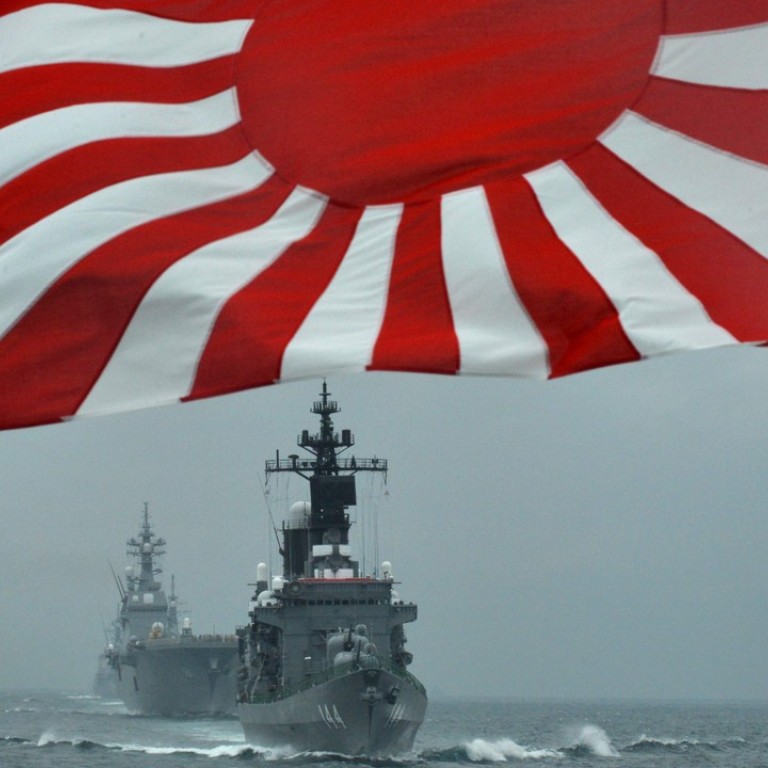
South Korean naval ships will dock in Japan, aiming to resolve row over ‘rising sun’ flag
The flag – a red sun with rays emanating from the centre – is identified by many as an unpleasant reminder of imperial Japan’s invasion and brutal occupation of large parts of mainland Asia in the early decades of the 20th century
Three South Korean warships are to dock in the Japanese port of Sasebo, Nagasaki Prefecture, later this month and take part in naval exercises with their local counterparts, a deployment the militaries of both nations hope will help resolve a diplomatic row over the flag of Japan’s Maritime Self-Defence Forces (MSDF).
The three ships will dock with about 600 cadets from the South Korean navy, army and air force, according to the defence ministry in Seoul, before going on to make a port call in the Russian city of Vladivostok.
Given the strained diplomatic ties between the two nations, analysts have suggested the South Korean defence ministry’s decision not to embark the cadets on the Dokdo – a 14,300-ton amphibious assault ship – during the visit was wise.
Dokdo is the Korean name for a pair of rocky islets about halfway between the mainlands of Japan and Korea presently controlled by South Korea. Tokyo claims the islands are part of its sovereign territory and should be known as Takeshima.
The decision to go ahead with the visit to Sasebo, which is also an important US naval base, was made despite ongoing rumblings of discontent on both sides over Tokyo’s refusal to lower the MSDF ensign to take part in the five-day naval review. The flag – a red sun with rays emanating from the centre – is identified by many as an unpleasant reminder of imperial Japan’s invasion and brutal occupation of large parts of mainland Asia in the early decades of the 20th century.
This is part of a broader pattern of rejection of symbols of Japanese imperialism and it sells well in South Korea
Last week, Lee Seok-hyun, a politician with the ruling Democratic Party of Korea, proposed a bill to ban vessels flying the “rising sun” flag from entering Korean territorial waters. The bill, if enacted, would also enable prosecution of anyone who produces, wears or sells anything that symbolises Japan’s colonial rule of the Korean peninsula, and for them to be fined up to 3 million won (US$2,600) or sentenced to up to two years in prison.
“This is part of a broader pattern of rejection of symbols of Japanese imperialism and it sells well in South Korea, especially when the focus at the moment is playing down tensions with North Korea,” said Stephen Nagy, a senior associate professor of politics at Tokyo’s International Christian University.
“But at the same time, the security establishment has the very clear understanding Japan poses no security threat. Indeed, we are seeing South Korea moving towards a stronger stance vis-à-vis China, so the South Korean military understands the bigger challenge going forward is not Japan and there is a need to cooperate with Japanese forces.”
The solution will not, however, completely reconcile the two sides, Nagy added, as a Japanese warship will inevitably will be scheduled to visit a South Korean port in the future and Tokyo will once again refuse to bow to pressure to lower the ensign that is the internationally recognised flag for its military vessels.
A similar situation has already arisen with China, which did not issue an invitation to the Japanese navy to take part in a similar international naval review in Qingdao in 2014.
It was, nevertheless, “the right decision” for the South Korean navy to announce the Dokdo would not be taking part in the visit because it is “needed to carry out operations in home waters,” said Nagy, who is also a fellow of Canada’s Asia-Pacific Foundation.
The squadron of three South Korean warships will be made up of the 4,000-ton destroyer Dae Jo Yeong and two amphibious landing vessels, the Cheon Wang Bong and the Il Chul Bong.

